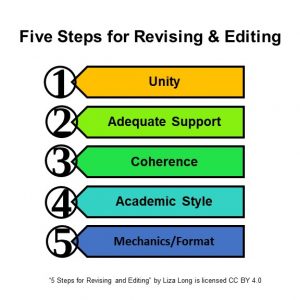32 How Can I Use AI to Edit and Revise my Persuasive Argument?
You’ll remember that in a previous chapter, we learned about the five stages of revising and editing. How can we use generative AI tools to assist in revising and editing our persuasive argument? Consider each of the five stages below:
 Revising for Unity: Have I presented a clear problem? Have I proposed a specific, concrete solution? Do all the parts of my paper support this problem and solution in some way? Write a prompt to ask a generative AI tool to check your paper for unity. Then use your preferred AI tool to check for this. Evaluate the AI’s results. Is this a good use of generative AI in the writing process? Why or why not?
Revising for Unity: Have I presented a clear problem? Have I proposed a specific, concrete solution? Do all the parts of my paper support this problem and solution in some way? Write a prompt to ask a generative AI tool to check your paper for unity. Then use your preferred AI tool to check for this. Evaluate the AI’s results. Is this a good use of generative AI in the writing process? Why or why not?
Revising for Adequate Support: One way to check for this is to make sure your paper uses the required sources and meets or exceeds (but not by too much!) the length requirements. How can you get generative AI to help you check whether you have adequate support? Does it make more sense to consider one section of your paper at a time, or does the tool work better when you ask about the entire paper? As you did in part one, evaluate the AI results. This is one area where I can see benefits to students—for example, if you have underdeveloped paragraphs, you can ask an AI tool to help you with your topic sentences and concluding sentences, or if you are “dead-dropping” your direct quotes, you can ask for help with integrating sources. Look over your own work and write a few prompts you can use to check for adequate support. Then try them out.
Revising for Coherence: This is the area where I personally struggle the most as a writer. When I’m revising for coherence or “flow” in my work, I first think about the overall organization of my work. This is one area where a generative AI tool may help you. How can you prompt a generative AI tool to help you check for this?Then I consider whether I am using clear transitional expressions in my work. However, this is one area where I have noticed tools like ChatGPT are both helpful and harmful. For example, the transitional expressions furthermore and moreover are both examples of “addition” transitional expressions. They help you to connect additional information to previous information.But do you actually use words like these? If not, consider how you might say this instead of using words that feel inauthentic to your voice as an author.
Revising for Style: This is the area where it’s most important that your human voice shines. In the past, we used to spend a lot of time getting people to write like robots. But now, robots can write technically correct papers about any subject. As we consider how writing in the age of artificial intelligence will change our writing process, this is one area where I am paying particular attention. In the past, I would have told students to revise for “academic style.” But now, I’d like you to revise for your style.
At this stage, you may want to use a generative AI tool to make sure that your tone is appropriately persuasive instead of objective. But beyond that use, I think the real work will come from ensuring that the writing sounds like you. If you aren’t sure what you sound like, take a few minutes to review examples of less formal writing you’ve done—on social media, for example. You could also make a quick video of yourself talking about the problem and solution. What kinds of words do you use? How does your passion for the solution come through in your speech? Make a note of these things (you could also consider using an AI transcription tool like Otter.ai or the talk-to-text dictation tool on your smartphone). Then comb through your paper to make sure that you see plenty of evidence for yourself as the writer.
Revising for grammar, spelling, punctuation, and syntax. Okay, at this point, if you aren’t using Word’s grammar checker or another tool like Grammarly to review your paper, why not? You now have access to assistance to make sure your writing is grammatically correct, and I expect you to use it. If you want to use a generative AI tool like Microsoft Copilot, ChatGPT, or Google Gemini, try using this prompt (one paragraph at a time): Tweak “[insert paragraph]. If it doesn’t work for you, you may need to add more context. Here’s a prompt you could use: “I am writing a problem/solution argument paper. Please check for grammar, spelling, punctuation, and syntax. Provide corrections to any errors and explain the corrections.”
Please make sure you acknowledge and cite your chats in an appendix at the end of your final paper. I’m especially interested in the prompts you may draft and in your feedback on how AI tools can assist you in this vital part of your writing process. But remember, especially in persuasive argument, you’ll want your human voice as an advocate to shine through.

